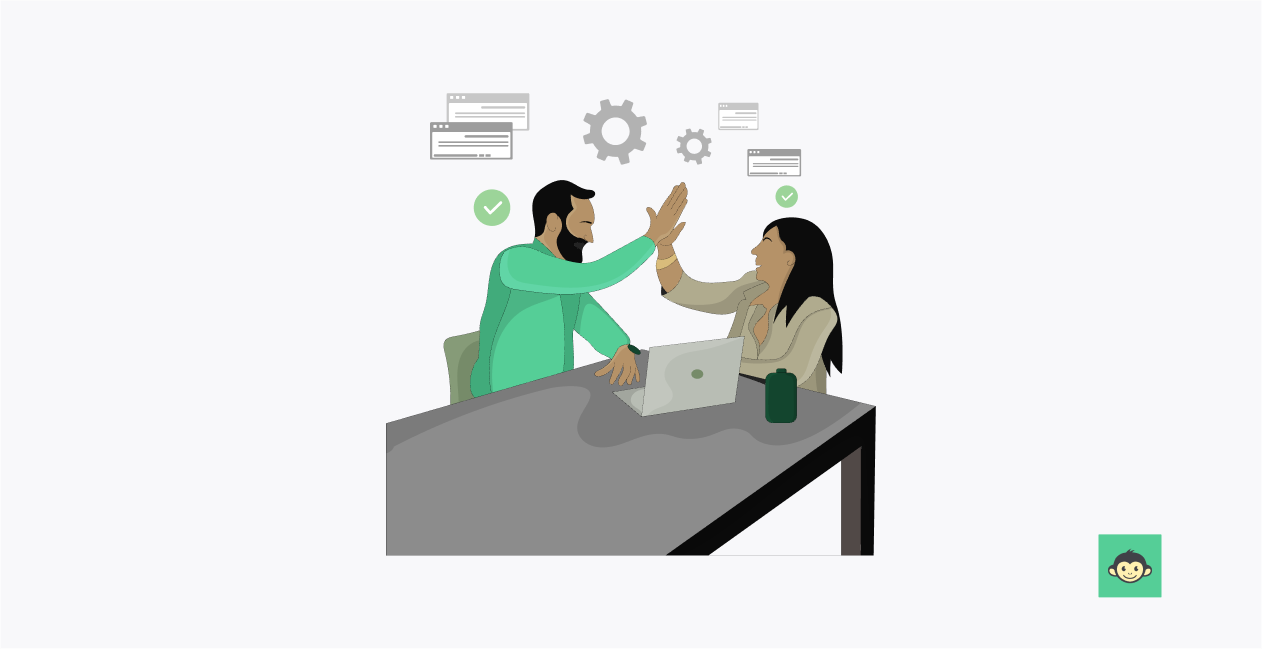What is employer-employee relationship: Benefits & best practices to improve workplace harmony

You know that feeling when you're part of a team that just clicks? It's like a perfectly orchestrated symphony where every note harmonizes effortlessly and feels right!
Well, in the whirlwind of modern workplaces, fostering a positive relationship between employers and employees is similar to discovering the secret ingredient that makes your organization truly special.
With that, let's dive into the world of employer-employee relationships! In today's fast-paced working environment, fostering a positive relationship between employers and employees is vital for both parties. We'll explore the meaning of this relationship and unravel the benefits and best practices that can enhance workplace harmony.
What is the relationship between employer and employee called?
The relationship between an employer and an employee is commonly referred to as the employer-employee relationship. This association represents a formal and contractual bond wherein an individual provides labor or services to an organization in exchange for compensation and benefits.
This relationship is governed by employment agreements, which outline the terms and conditions of employment, including roles, responsibilities, and remuneration.
Central to the employer-employee relationship is a set of expectations that both parties uphold. Employers are responsible for providing a conducive work environment, fair compensation, and opportunities for professional development.
Conversely, employees are expected to perform their duties diligently, adhere to company policies, and contribute to the overall success of the organization.
The employer-employee relationship extends beyond mere transactional engagement; it encompasses aspects of mutual respect, trust, and collaboration.
Effective internal communication, transparent policies, and a commitment to fostering a positive work culture are integral components in nurturing a strong and symbiotic connection between employers and employees.
Ultimately, this relationship plays a pivotal role in the productivity, satisfaction, and success of both the individual and the organization.
What is the meaning of the employer-employee relationship?

At its core, the employer-employee relationship is a symbiotic bond between an organization and its workforce. It's not just about job titles and paychecks; it encompasses the dynamics, interactions, and mutual responsibilities between those who provide the work (employees) and those who provide the jobs (employers).
The employer-employee relationship is the heart of any organization. It's more than job titles and paychecks; it's the give-and-take between employees and employers. Employees contribute their skills and effort, while employers provide opportunities and support.
It's like a dance, where both partners work together to create a harmonious and productive workplace. This relationship's success not only benefits the organization but also the well-being and growth of its employees, making it crucial for success.
Nature of relationship between employer and employee

The nature of the relationship between an employer and an employee is characterized by a complex interplay of professional, contractual, and interpersonal dimensions.
On a contractual level, the relationship is formalized through an employment agreement, delineating the terms, responsibilities, and compensation.
Professionally, it involves the employee's commitment to fulfilling assigned duties and the employer's obligation to provide a conducive work environment and fair remuneration.
Beyond the formal aspects, the nature of this relationship also encompasses interpersonal dynamics. Trust, effective communication, and mutual respect contribute to a positive working alliance. Employers play a crucial role in fostering a supportive atmosphere, while employees, in turn, contribute to the overall success of the organization.
This dynamic interdependence underscores the intricate nature of the employer-employee relationship, where both parties influence and rely on each other for collective prosperity and growth.
What are the four elements of the employer-employee relationship?

The employer-employee relationship is multifaceted and comprises several key elements contributing to its overall dynamics and effectiveness. Here are the four essential elements:
1. Mutual expectations
Both the employer and the employee have specific and clear expectations, from their relationship. Employers expect employees to perform their job duties, meet productivity targets, and contribute to the organization's success. Conversely, employees expect fair compensation, job security, opportunities for growth, and a safe, respectful work environment.
2. Mutual commitment
Commitment is a crucial element in this relationship. Employers commit to providing regular pay, benefits, adequate training throughout, and a supportive work environment. On the other side, employees commit to dedicating their time, skills, and efforts to fulfill their job responsibilities and contribute to the company's goals.
3. Communication and feedback
Effective communication is essential for a healthy employer-employee relationship. Employers should provide clear job expectations, feedback on performance, and opportunities for employees to voice their concerns or suggestions. Conversely, employees should communicate openly about their needs, challenges, and ideas.
4. Trust and respect
Trust and respect are the foundation of any strong relationship. Employers must trust employees to perform their duties competently and ethically. Likewise, employees need to trust that their employment contract with their employer will provide fair compensation, a safe workplace, and opportunities for growth.
Respect for each other's opinions, ideas, and boundaries is also crucial in maintaining a positive relationship.
These four elements form the basis of a successful employer-employee relationship. When both parties understand and fulfill their roles in these areas, it leads to a more harmonious mutually respectful relationships, and productive work environment. These factors have a big influence on employee engagement and employees' level of trust in the organization.
What is the traditional employer-employee relationship?
The traditional employer-employee relationship is a structured arrangement where an individual, the employee, enters into a formal agreement with an employer to exchange labor or services for compensation.
This relationship has historically been characterized by a hierarchical structure, where employers hold authority and employees follow established directives.
Employment terms and conditions, including job responsibilities, working hours, and compensation, are typically outlined in employment contracts or agreements.
In this conventional model, employers assume the role of decision-makers, setting organizational goals and managing the overall direction of the company. Employees, on the other hand, are expected to fulfill assigned tasks within the scope of their roles.
The structure often includes performance assessments, periodic reviews, and potential avenues for career progression within the organization.
Benefits and responsibilities are clearly defined, and job security has traditionally been a hallmark of this relationship.
Employers provide stability, a consistent income, and, in some cases, additional perks such as healthcare and retirement benefits. In return, employees are expected to contribute their skills, time, and efforts to advance the objectives of the organization.
While this traditional model still forms the foundation of many employment relationships, contemporary workplaces are witnessing shifts towards more collaborative and flexible arrangements.
Employers are recognizing the importance of employee engagement, work-life balance, and a positive workplace culture, leading to adaptations in the traditional employer-employee dynamics to meet evolving expectations and preferences.
What is employee and supervisor relationship?

The employee-supervisor relationship is a critical aspect of the professional dynamics within an organization. It is characterized by a structured and hierarchical association where a supervisor, typically a higher-ranking individual in the organizational hierarchy, oversees the work and performance of an employee or a team of employees.
This relationship is governed by the principles of leadership, guidance, and collaboration to achieve organizational goals.
Supervisors play a pivotal role in providing direction, setting expectations, and evaluating the performance of their subordinates. They are responsible for communicating organizational objectives, ensuring clarity regarding job responsibilities, and providing necessary resources for their team's success.
The relationship demands effective communication, where supervisors offer constructive feedback and guidance to enhance employee performance.
Employees, in turn, are accountable for fulfilling their roles, meeting performance expectations, and collaborating with their supervisors to contribute to the overall success of the organization.
A positive employee-supervisor relationship is characterized by trust, mutual respect, and open communication. It is essential for creating a positive work environment that fosters productivity, job satisfaction, and professional growth.
Effective employee-supervisor relationships often extend beyond the immediate work-related interactions, encompassing mentorship, professional development, and support.
These relationships contribute significantly to employee engagement, job satisfaction, and the overall success of the organization by fostering a collaborative and motivated workforce.
Employer-employee relationship benefits

Nurturing a positive and productive employer-employee relations in today's competitive job market allows organizations to enjoy higher employee satisfaction, lower turnover, and better overall performance. Here are some other benefits –
Increased productivity
A strong employee-employer relationship can significantly boost productivity. When employees feel valued and engaged, they are more motivated to perform at their best. This increased dedication and focus translate into higher efficiency and output.
Example: A study by the Harvard Business Review found that companies with engaged employees experience 22% higher productivity.
Lower employee turnover
Building a strong employee-employer relationship reduces turnover rates. Employees who are satisfied with their working conditions and feel appreciated are less likely to seek employment elsewhere. This saves organizations the time and cost associated with recruiting and training new staff.
According to the Society for Human Resource Management (SHRM) it can cost up to six to nine months' salary to replace an employee.
Enhanced job satisfaction
Job satisfaction is a key driver of employee retention and overall happiness. When employees have a good relationship with their employers, they are more likely to find their work fulfilling and rewarding.
A Gallup poll reported that employees who feel their opinions are heard at work are 4.6 times more likely to feel empowered to perform their best.
Improved employee well-being
A strong employer-employee relationship can contribute to improved mental and emotional well-being among employees. When they feel supported and valued, they experience less stress and job-related burnout.
The American Psychological Association (APA) found that 89% of employees at companies with well-being initiatives are more likely to recommend their company as a good workplace.
Higher employee engagement
Engaged employees are more committed to their work and the organization's mission. They are also more likely to go above and beyond their job descriptions to contribute to the company's success. According to Gallup, companies with engaged employees outperform their peers by 147% in earnings per share.
Better teamwork and collaboration
A positive employer-employee relationship fosters a culture of teamwork and collaboration. When employees feel comfortable communicating with their employers and colleagues, it leads to smoother workflows and more innovative problem-solving.
Google's research on high-performing teams found that psychological safety, which includes trust and respect, is a key factor in team success.
Reduced workplace conflicts
Effective communication and mutual respect can minimize workplace conflicts. Employees who can openly discuss concerns with their employers are more likely to resolve issues before they escalate.
A study by CPP Inc. found that 85% of employees experience workplace conflict to some degree, but constructive conflict resolution can lead to better outcomes.
Increased employee loyalty
A positive employer-employee relationship fosters a sense of loyalty among employees. Loyal employees are more likely to stay with the organization during challenging times and actively contribute to its long-term success.
Flexible work arrangements
Offering flexible work arrangements strengthens the employer-employee relationship by showing consideration for employees' work-life balance. This can include options like remote work, flexible hours, or compressed workweeks.
Professional development opportunities
Providing opportunities for professional growth and development enhances the employer-employee relationship. When employees see that their organization invests in their skills and career progression, they are more likely to stay and contribute to the company's success.
Recognition and rewards
Acknowledging employees' contributions through recognition programs and rewards reinforces a positive employer-employee relationship. Recognition fosters a sense of accomplishment and motivates employees to continue excelling in their roles.
Health and wellness initiatives
Investing in employee health and wellness initiatives contributes to a positive employer-employee relationship. Organizations that prioritize employee well-being by offering wellness programs, gym facilities, or mental health support create a healthier and more engaged workforce.
It’s easy to see that by investing in and fostering a strong employer-employee relationship, companies can create a thriving work environment that not only attracts top talent but also retains and maximizes the potential of their existing workforce.
Define employee relations

Employee relations refers to the intricate and multifaceted interactions and dynamics between employers and employees within an organizational context. It encapsulates the policies, practices, and strategies aimed at managing and enhancing the relationship between the workforce and the employer.
Central to any employer/HR and employee relations is the establishment of a positive and productive work environment where communication is open, trust is cultivated, and conflicts are addressed constructively.
This field encompasses a wide array of activities, including conflict resolution, performance management, employee engagement initiatives, and the development of fair and transparent policies.
An effective employee relations department is essential for creating a harmonious workplace, fostering employee satisfaction, and contributing to the overall success and sustainability of the organization. It involves a proactive and strategic approach to building a cohesive and mutually beneficial partnership between employers and employees.
What is employer-employee relationship management?

Employer-employee relationship management refers to organizations' strategies and practices to foster positive and productive connections between employers (management) and employees. It encompasses the dynamics, interactions, and mutual responsibilities within the workplace.
Effective employee and employer relationship management aims to create an environment where both parties are satisfied, engaged, and motivated to work collaboratively toward common goals.
Employer-employee relationship management is the roadmap for how an organization cultivates an atmosphere of teamwork and mutual respect. It involves setting clear expectations, promoting open communication, addressing concerns, and recognizing achievements.
By nurturing this relationship, organizations unlock the potential for greater innovation, higher job satisfaction, and improved overall performance.
William Sipling, Director of Workforce Transformation at Hubstaff, states that successful employee and employer relations must be built on a just and ethical foundation. “A business leader must remember that their employees are why their company is successful and prosperous.
Therefore, because of workers’ investments in the organization through their labor, effort should be placed on treating employees rightly, both socially and materially.
This means employers have an obligation to provide a culture of respect and safety (socially) and also to compensate them fairly and equitably (materially).”
Ways to enhance the employer-employee relationship

To help you navigate this essential aspect of the modern workplace, we've compiled a list of strategies to enhance the employee-employer relationship. These approaches should serve as guideposts for creating a work environment where collaboration, growth, and appreciation thrive.
Open communication
Encouraging open, transparent, and regular communication between employers and employees creates an atmosphere where ideas flow freely, and concerns are addressed promptly.
Active listening, where both parties genuinely hear and understand each other, fosters a sense of mutual respect and trust. An open-door policy ensures that employees feel comfortable approaching their superiors with questions, suggestions, or challenges, ultimately promoting a culture of dialogue and understanding.
Recognition and appreciation
Recognition is like a warm ray of sunshine in the workplace. Acknowledging and rewarding employees' hard work and achievements not only boosts morale but also reinforces the value of their contributions.
Employee recognition programs formalize this process, making it a consistent part of the organizational and company culture here. From verbal praise in team meetings to more structured awards and incentives, recognition and appreciation serve as powerful motivators that fuel employee dedication and enthusiasm.
Professional development
Investing in your employees' growth is an investment in the future of your organization. Providing opportunities for skill development and career advancement demonstrates a commitment to their personal and professional journey.
This can include offering workshops, courses, mentoring programs, or cross-functional training. When employees see that their organization is dedicated to helping them grow, they're more likely to reciprocate with increased loyalty and a deeper sense of engagement.
Work-life balance
Balancing the demands of work and personal life is a challenge many employees face. Offering flexible work arrangements, such as remote work options, flexible hours, or compressed workweeks, goes a long way in promoting a healthy work-life balance. When employees have the flexibility to manage their time effectively, they're happier and more productive.
Fair compensation
Competitive compensation packages, salaries and benefits are tangible ways to show employees that their efforts are valued and appreciated. Fair compensation not only attracts top talent but also retains experienced and dedicated staff.
It's a fundamental aspect of demonstrating that the organization recognizes the significance of their contributions. When employees feel fairly compensated, they are more likely to remain motivated, committed, and invested in their work.
Opportunities for team-building activities
Organizing team-building activities outside the regular work environment fosters a sense of camaraderie among employees. These activities can include retreats, workshops, or even simple team lunches.
Team-building helps strengthen relationships, improve communication, and create a positive and collaborative work culture.
Flexible work arrangements
Continuing to adapt to the evolving needs of employees, organizations can explore additional flexible work arrangements. This might involve implementing policies like job-sharing, sabbaticals, or extended parental leave.
Offering diverse options for work flexibility demonstrates a commitment to employees' well-being and individual needs.
Regular performance feedback
Establishing a system of regular performance feedback ensures that employees are aware of their strengths and areas for improvement. This ongoing dialogue between employers and employees promotes continuous growth and development.
Timely feedback also prevents misunderstandings and allows for adjustments in tasks or goals, contributing to a more constructive and supportive work environment.
Inclusive and diverse workplace initiatives
Promoting diversity and inclusion in the workplace is essential for a harmonious employer-employee relationship.
Implementing initiatives that celebrate diversity, such as diversity training, employee assistance programs, and employee resource groups, creates a more inclusive atmosphere. A diverse workforce fosters innovation and brings different perspectives to the table, contributing to the overall success of the organization.
By implementing these strategies, organizations can create an environment where positive relationships, collaboration, growth, and appreciation flourish. These guideposts pave the way to a workplace where employer-employee relationships are not just productive but also fulfilling, contributing to the overall success and well-being of both parties.
5 Employee-employer relationship examples

These relationships vary widely, like a colorful tapestry with unique threads. To explore this diversity, let's dive into five intriguing examples that showcase the different ways these connections can thrive.
Tech giants' employee perks
Companies like Google and Facebook are known for their comprehensive employee perks, including gourmet meals, on-site wellness facilities, and personal and professional growth opportunities.
These companies have crafted a reputation for offering a smorgasbord of perks, from gourmet meals that turn lunch breaks into a culinary adventure, to on-site wellness facilities that encourage a healthy work-life balance.
Yet, what truly sets them apart is their commitment to personal and professional growth. Employees here have access to learning opportunities, training, and career development that rivals any academic institution, creating an environment where both work and personal growth thrive in harmony.
Startup collaborative culture
Many startups foster close-knit relationships by encouraging collaboration, innovation, and a sense of ownership among employees. Here, relationships go beyond a mere exchange of tasks; they are the lifeblood of innovation.
Startups encourage collaboration, innovation, and a sense of ownership among employees. It's not unusual to find team members wearing multiple hats, contributing to various aspects of the business.
Family-owned businesses
In family-owned businesses, a strong employer-employee relationship often exists due to the personal investment of the owners in the well-being of their employees. Family-owned businesses exude a unique charm. Here, the employer-employee relationship often flourishes due to the personal investment of the owners in the well-being of their employees.
It's akin to being part of an extended family where everyone's contributions are not only valued but celebrated. In such organizations, loyalty is not just a word; it's a way of life. There's a strong sense of trust, stability, and an unwavering commitment to the success and happiness of each team member.
Nonprofits and passion-driven work
Working for a nonprofit organization is like finding your true calling. These organizations are often filled with employees who are highly engaged, passionate, and purpose-driven. The secret sauce here is alignment. Employees find meaning in their work because they are closely tied to the organization's mission and values.
Remote work adaptation
The COVID-19 pandemic triggered a seismic shift in the way we work. Companies adapted to remote work, emphasizing trust and flexibility in the work setting. This transformation has redefined the employer-employee relationship, as it hinges on clear communication, self-discipline, and a mutual understanding of the unique challenges remote work presents.
Trust, independence, and adaptability have become the cornerstones of these relationships, as organizations have recognized the need to embrace the changing nature of work.
These examples remind us that there's no one-size-fits-all solution for building robust employer-employee relationships. Instead, it's about understanding the particular dynamics of each workplace and crafting relationships that resonate with the organization's culture and the individuals who fuel its success.
Challenges in establishing a good employer-employee relationship

Creating a strong bond between employers and employees is a bit like building a bridge. It's a journey that involves overcoming some common obstacles. In this section, we'll explore these challenges, which are like stepping stones on the path to a successful working relationship.
These challenges are part and parcel of the workplace landscape, from clear communication to managing workload and navigating organizational changes. Organizations can construct a sturdier bridge between employers and employees by understanding and addressing them.
Let's take a closer look at these challenges and how to navigate them effectively.
Communication barriers
Miscommunication or ineffective communication can lead to misunderstandings, creating rifts in what should be a smooth connection. These barriers can take many forms, from unclear expectations to misinterpreted feedback. Overcoming this challenge involves establishing a culture of clear and open communication, active listening, and a commitment to resolving issues through dialogue.
Diversity and inclusion
Understanding and respecting cultural differences can be a complex endeavor, but it's essential for building strong employer-employee relationships. It's not just about acknowledging diversity; it's about creating an environment where everyone feels valued and included, regardless of their backgrounds.
This challenge involves promoting cultural awareness, providing diversity training, and encouraging a culture of respect and inclusivity.
Leadership and management styles
Differences in leadership and management styles can pose a challenge. Some employees may prefer a more hands-off management approach, while others thrive under more structured guidance. Striking a balance that caters to diverse preferences can be demanding.
Performance evaluation and feedback
Providing constructive feedback and conducting performance evaluations can be tricky. Employees may feel anxious or undervalued during these processes if not handled correctly. Establishing a fair and effective feedback system is essential.
Career growth and advancement:
Clear pathways for career growth and advancement within the organization are crucial. When employees don't see opportunities for professional development and advancement, they may become disengaged.
Employee recognition
Recognizing and appreciating employees' efforts on an ongoing basis is a challenge. If employees feel their contributions are not acknowledged, it can lead to disengagement and reduced job satisfaction.
Conflict resolution
Workplace conflicts can arise from time to time. The challenge is in resolving these conflicts constructively. Employers must have effective conflict resolution mechanisms in place to maintain a positive atmosphere.
Addressing these additional challenges requires proactive strategies, an understanding of employee needs, and a commitment to open communication and flexibility.
Work-life balance
Balancing work and personal life is an ongoing challenge that can impact the employer-employee relationship. In today's fast-paced work environment, employees may struggle with burnout and stress, affecting their overall well-being.
Organizations need to implement policies that support a healthy work-life balance, such as flexible work hours, telecommuting options, and clear boundaries for after-hours communication.
Technology integration
The rapid evolution of technology can present challenges in maintaining a good employer-employee relationship. Overreliance on digital communication, such as emails and messaging apps, may lead to a lack of face-to-face interaction.
Striking a balance between utilizing technology for efficiency and ensuring meaningful personal connections is vital for a positive working relationship. Employers must navigate the integration of technology thoughtfully to avoid feelings of isolation among employees.
Conclusion
Employer-employee relationship management is the cornerstone of success in today's competitive job market and when employees have a strong, healthy relationship with their employers, the entire company benefits.
Cultivating a positive and productive connection between employers and employees offers benefits, from improved productivity to happier, more engaged team members.
Our journey through various examples, such as tech giants and startups, shows that while approaches may differ, the core principles of open communication, recognition, professional development, work-life balance, and fair compensation hold across the board.



